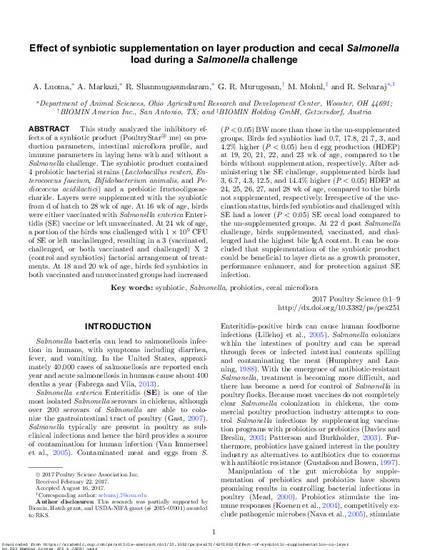
Article
Effect of synbiotic supplementation on layer production and cecal Salmonella load during a Salmonella challenge
Poultry Science
(2017)
Abstract
This study analyzed the inhibitory effects of a synbiotic product (PoultryStar® me) on production parameters, intestinal microflora profile, and immune parameters in laying hens with and without a Salmonella challenge. The synbiotic product contained 4 probiotic bacterial strains (Lactobacillus reuteri, Enterococcus faecium, Bifidobacterium animalis, and Pediococcus acidilactici) and a prebiotic fructooligosaccharide. Layers were supplemented with the synbiotic from d of hatch to 28 wk of age. At 16 wk of age, birds were either vaccinated with Salmonella enterica Enteritidis (SE) vaccine or left unvaccinated. At 24 wk of age, a portion of the birds was challenged with 1 × 109 CFU of SE or left unchallenged, resulting in a 3 (vaccinated, challenged, or both vaccinated and challenged) X 2 (control and synbiotics) factorial arrangement of treatments. At 18 and 20 wk of age, birds fed synbiotics in both vaccinated and unvaccinated groups had increased (P < 0.05) BW more than those in the un-supplemented groups. Birds fed synbiotics had 0.7, 17.8, 21.7, 3, and 4.2% higher (P < 0.05) hen d egg production (HDEP) at 19, 20, 21, 22, and 23 wk of age, compared to the birds without supplementation, respectively. After administering the SE challenge, supplemented birds had 3, 6.7, 4.3, 12.5, and 14.4% higher (P < 0.05) HDEP at 24, 25, 26, 27, and 28 wk of age, compared to the birds not supplemented, respectively. Irrespective of the vaccination status, birds fed synbiotics and challenged with SE had a lower (P < 0.05) SE cecal load compared to the un-supplemented groups. At 22 d post Salmonella challenge, birds supplemented, vaccinated, and challenged had the highest bile IgA content. It can be concluded that supplementation of the synbiotic product could be beneficial to layer diets as a growth promoter, performance enhancer, and for protection against SE infection.
Disciplines
Publication Date
December, 2017
DOI
https://doi.org/10.3382/ps/pex251
Citation Information
G. R. Murugesan, Amanda Luoma, Ashley Markazi, Revathi Shanmugasundaram, et al.. "Effect of synbiotic supplementation on layer production and cecal Salmonella load during a Salmonella challenge" Poultry Science Vol. 96 Iss. 12 (2017) p. 4208 - 4216 Available at: http://works.bepress.com/raj_murugesan/12/
